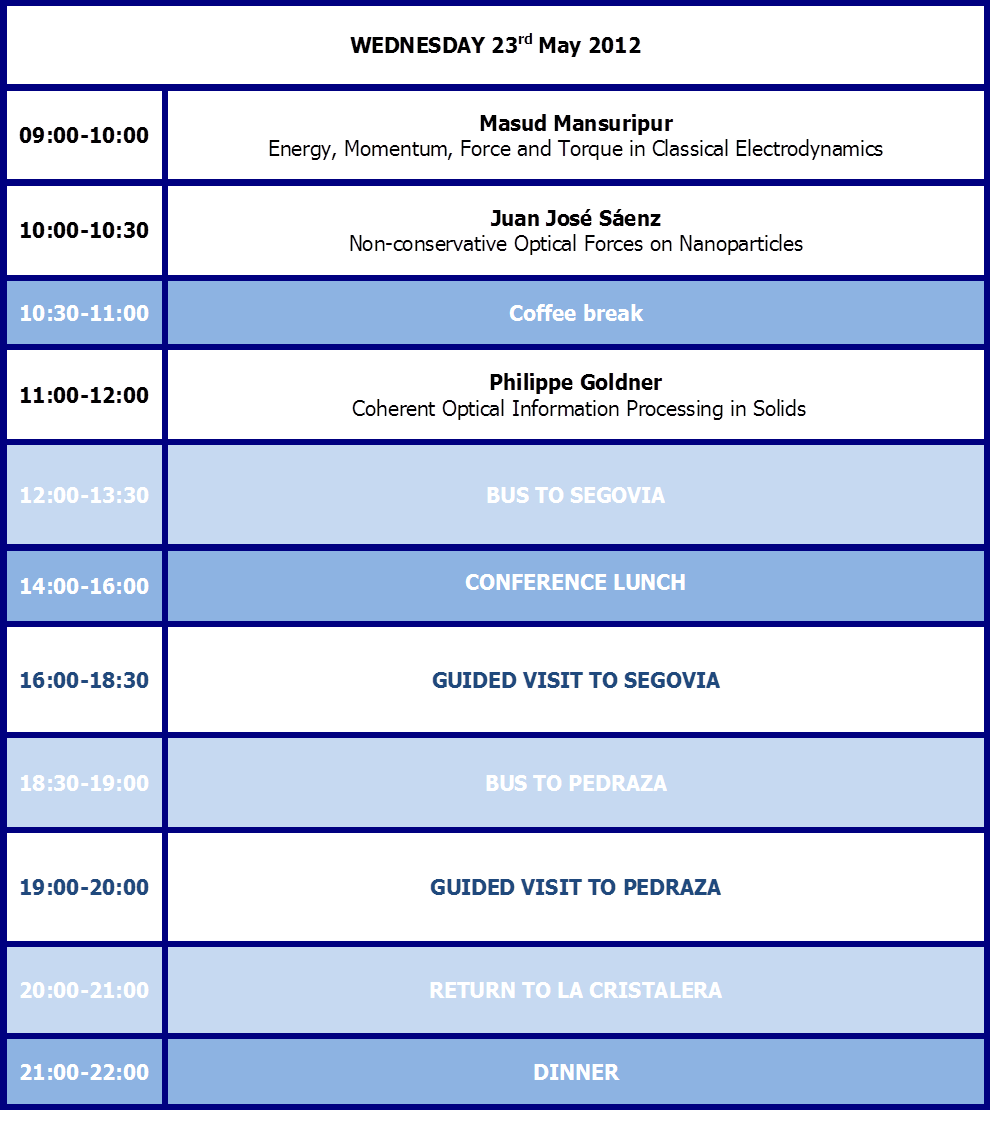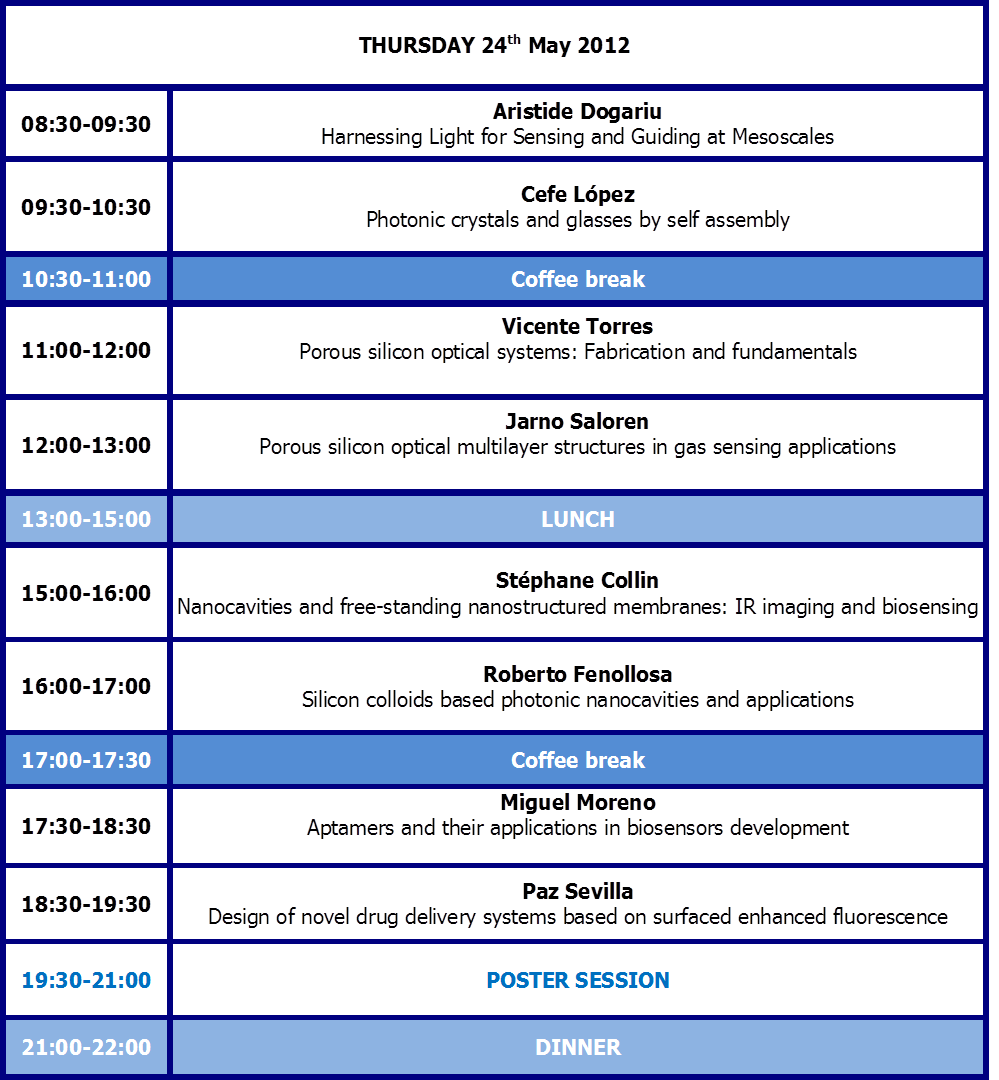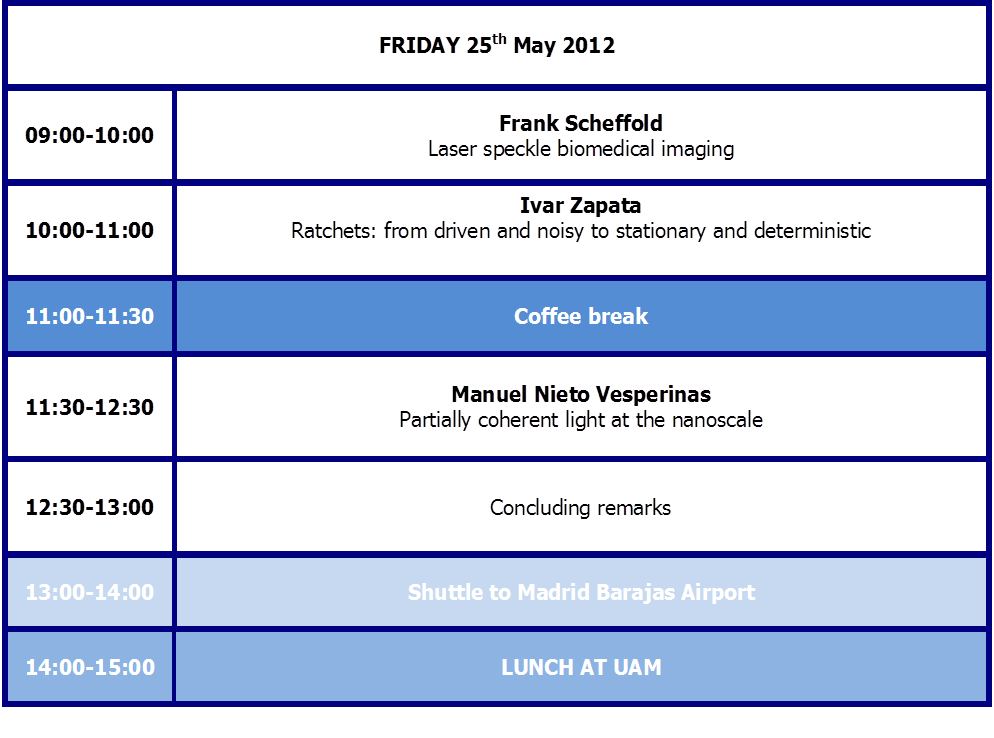Spring School 2012
International Spring School of the MICROSERES Comunidad de Madrid Consortia
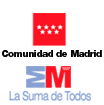
Advanced Processes in Optical Sensing
and Photonic Applications
“La Cristalera”, Miraflores de la Sierra, Madrid, 21-25 May (2012)
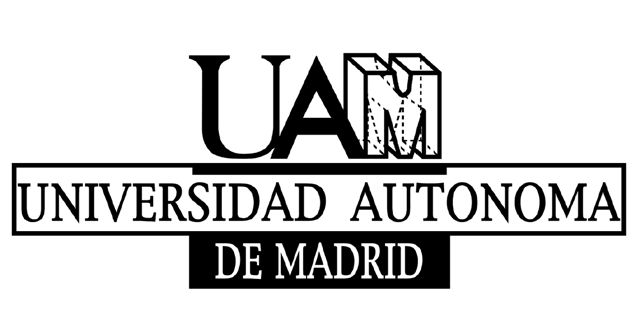


Organizing Committee:
SPONSORS:

OBJETIVES:
The MICROSERES Program, founded by the Comunidad Autónoma de Madrid, organizes the International School on Advanced Processes in Optical Sensing and Photonic Applications.
The main goal of the School is to promote and boosts multidisciplinary discussions in physics, optics, biotechnology, chemistry, microelectronics and nanotechnology, in order to explore new concepts and sensing components based on photonic micro-nanosensors. To this aim, we will bring together scientific leaders of research groups from around the world and create an atmosphere of discussion in which both junior and senior researchers would participate in understanding the recent advances in all these fields.
Among other relevant topics, the Lectures will cover discussions on:
PROGRAM:
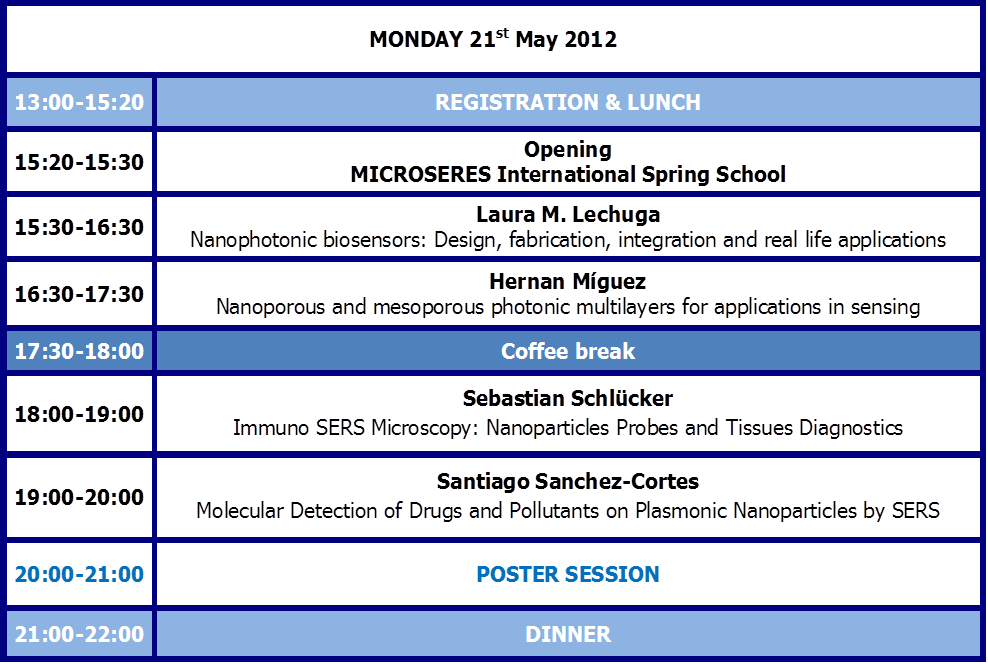
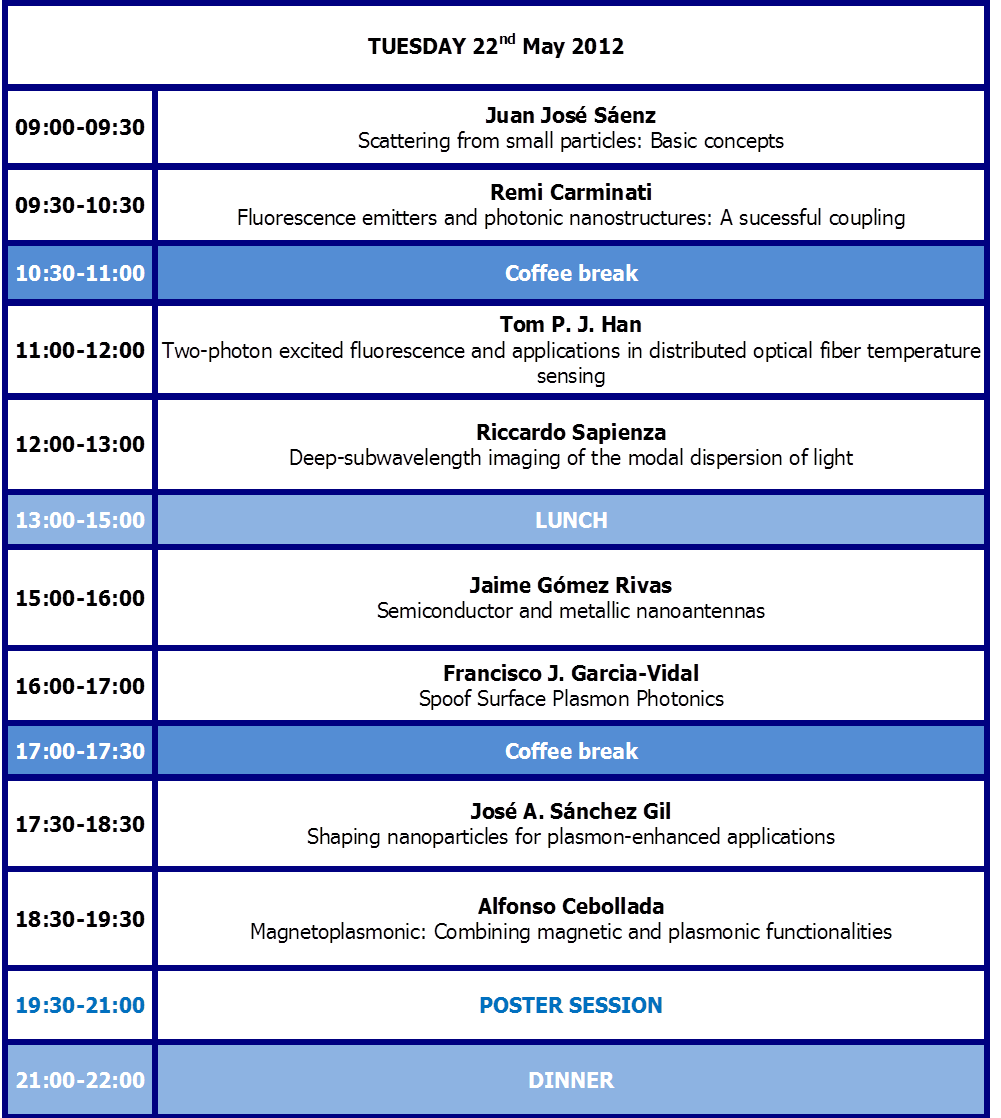
LECTURERS:
- Remi Carminati (Institute Langevin, ESPCI-CNRS, Paris, France)
(Fluorescence emitters and photonic nanostructures: A sucessful coupling) - Alfonso Cebollada (IMM-CNM-CSIC, Spain)
(Magnetoplasmonic: Combining magnetic and plasmonic functionalities) - Stéphane Collin (Laboratoire de Photonique et de Nanostructures, CNRS, France)
(Nanocavities and free-standing nanostructured membraned: IR imaging and biosensing) - Aristide Dogariu (CREOL, The College of Optics and Photonics, USA)
(Harnessing Light for Sensing and Guiding at Mesoscales) - Roberto Fenollosa (UPV-CSIC, Spain)
(Silicon colloids based photonic nanocavities and applications) - Francisco J. García-Vidal (UAM, Spain)
(Spoof surface plasmon photonics) - Philippe Goldner (Chimie-ParisTech, France)
(Coherent Optical Information Processing in Solids) - Jaime Gómez-Rivas (AMOLF, The Netherlands)
(Metallic and semiconducting nanoantennas) - Tom P.J. Han (Strathclyde University, Scotland, UK)
(Two-photon excited fluorescence and applications in distributed optical fiber temperature sensing) - Laura Lechuga (CIN2, Spain)
(Nanophotonic biosensors: Design, fabrication, integration and real life applications) - Cefe López (ICMM-CSIC, Spain)
(Photonic crystals and glasses) - Masud Mansuripur (College of Optical Sciences, Univ. Arizona, USA)
(Energy, Momentum, Force and Torque in Classical Electrodynamics) - Hernan Míguez (ICMSE-CSIC, Spain)
(Nanoporous and mesoporous photonic multilayers for applications in sensing) - Miguel Moreno (Centro de Astrobiología, INTA-CSIC, Spain)
(Aptamers and their applications in biosensors development) - Manuel Nieto-Vesperinas (ICMM-CSIC, Spain)
(Partially coherent light at the nanoscale) - Juan José Sáenz (UAM, Spain)
(Introduction to light forces, scattering and absorption from small particles) - Jarno Salonen (Univ. Turku, Finland)
(Porous silicon optical multilayer structures in gas sensing applications) - Santiago Sánchez-Cortés (IEM-CSIC, Spain)
(Molecular Detection of Drugs and Pollutants on Plasmonic Nanoparticles by SERS) - José A. Sánchez-Gil (IEM-CSIC, Spain)
(Shaping nanoparticles for plasmon-enhanced applications) - Riccardo Sapienza (King’s College London, UK)
(Deep-subwavelength imaging of the modal dispersion of light) - Frank Scheffold (Univ. Fribourg, Switzerland)
(Laser speckle biomedical imaging) - Sebastian Schluecker (Univ. Osnabruck, Germany)
(Immuno SERS Microscopy: Nanoparticles Probes and Tissues Diagnostics) - Paz Sevilla (UCM, Spain)
(Design of novel drug delivery systems based on surfaced enhanced fluorescence) - Vicente Torres (UAM, Spain)
(Porous silicon optical systems: fundamentals and applications) - Ivar Zapata (UCM, Spain)
(Ratchets: from driven and noisy to stationary and deterministic)
REGISTER
Normal Fee: 400 EUROS
Including: Registration
4 days Full board: (Breakfast, lunch, dinner,4 nights – double room sharing)
Coffee breaks
Official School Dinner
Shuttle bus
Local Fee: 200 EUROS
Including: Registration
4 lunch
Coffee breaks
Official School Dinner
Interested participants should send the REGISTRATION FORM (as soon as possible, due to the limited number of available places).
Please fill out the POSTER FORM if you wish to present a poster.
(Please notice that you should also submit a filled registration form to participate in the school).
PAY FORM Details for payment and the pay form will be sent after receiving the registration form.
VENUE
The Summer Residence of the Universidad Autónoma de Madrid, located in Miraflores de la Sierra (La Cristalera) a nice mountain resort 50 km out of the city of Madrid.
{source}
{/source}
See La Cristalera bigger map on new window
Shuttle bus Madrid-Barajas Airport — UAM — Miraflores Monday, May 21, 12:00
Lunch at “La Cristalera” 13:30 -15:00
Lectures starting at 15:30
Departure on Friday, May 25
Closing remarks 12:45
Shuttle bus 13:00 Miraflores – UAM- Madrid-Barajas Airport –
(Optional: Lunch at UAM-CSIC Campus)

TOURIST INFO
Arrival by plane:
You can reach Miraflores by taxi from the airport but this is an expensive choice (minimum 90.00 Euro, but please ask before for a price).
You can also take a taxi from the Airport to Plaza Castilla (approximate fare: 45.00 Euro) and then take a bus to Miraflores.
A good choice is taking Metro from Airport to Plaza Castilla and then a bus to Miraflores. At the airport, take Metro (underground), Line 8 (pink) to “Colombia” (3 stations). Transfer in Colombia to line 9 (purple) to “Plaza de Castilla” (3 stations). It should take about 25 minutes. You will find more info at the Metro webpage . In any case you can ask for a map of Metro for free when you buy a ticket.
Once you have reached Plaza Castilla there are a lot of bus stops between the two big inclined towers. Only one ( 725) goes to Miraflores de Sierra. Search number 725 (Madrid – Pza Castilla to Miraflores de la Sierra, Bustarviejo). Here you find a timetable of the bus 725 for Saturday and Sunday ( bottom part indicated in Spanish as “Sabados Laborables, Domingos y Festivos”).
Taxi from Pza. Castilla to Miraflores costs minimum 60.00 Euro.
The trip to Miraflores de la Sierra takes approximately 60 minutes and departure is aprox. each hour from 7.30 a.m. till 23.15 p.m. Your stop is the next after “Soto del Real”.
One way ticket to Miraflores by bus 725 costs 2.75 Euro.
Arrival by train:
Coming from the North, the train station is usually Chamartin. From Chamartin, you can take the Metro (line 10: dark blue) to Plaza de Castilla but it is only one station and it is also easy to walk from Chamartin to Pza Castilla. If you arrive at Atocha, you can take the Metro (line 1: light blue, 13 stations) to Plaza Castilla and follow the above mentioned instructions for the bus.
Arrival by car:
Take the big periferial highway M-40. If you come from the south, Portugal, or the Zaragoza Highways, take direction North (N-I). If you come from the Burgos Highway (N-I) take the direction M-607 Tres Cantos- Colmenar Viejo. Go out of the M-40 to the M-607 Highway towards Tres Cantos-Colmenar viejo. When the Highway ends (roughly 30 km) take the direction Miraflores. After 30 km you will reach the village. Once there, follow the signs towards La Cristalera, or Puerto de la Morcuera. One km outside the village you will find the entrance to the residence on your left (but watch out for it since sign is not a big one and may be missed )
How to reach La Cristalera Residence:
La Cristalera is located at the route from Miraflores to Puerto de la Morcuera, one kilometer distance outside Miraflores. Miraflores de la Sierra is a vacations resort located at the mountains in the North of Madrid. There is no bus service between Miraflores and La Cristalera. In case of emergency, you can phone to the Residence by phones indicated below.
In any case, PLEASE NOTIFY US ABOUT YOUR ARRIVAL DATE AND TIME. We will try to organize transportation from the bus stop to the Residence for you, so that you can reach the residence without too much walking.
Telephone numbers of the residence for international calls are:
(+34 91) 844 3920/ (+34 91) 844 3989.
Also, please note that accomodation is in a shared double room (except invited speakers), so please do not forget to notify us your preferences to share the room. If you plan to come with somebody else who would NOT attend the conference, please notify us AS SOON AS POSSIBLE, as we would need to search for another accommodation for you. In the case that you want more information about Madrid, here are some related links that could be of interest for you:
Madrid Related Links
TOURIST INFORMATION OF MADRID:
gomadrid
aboutmadrid
descubremadrid
MUSEUMS
Museo del Prado
Museo Nacional Centro de Arte Reina Sofia
Museo Thyssen-Bornemisza
Weather Information
Weather Forecast
Madrid Yahoo! Weather Forecast



